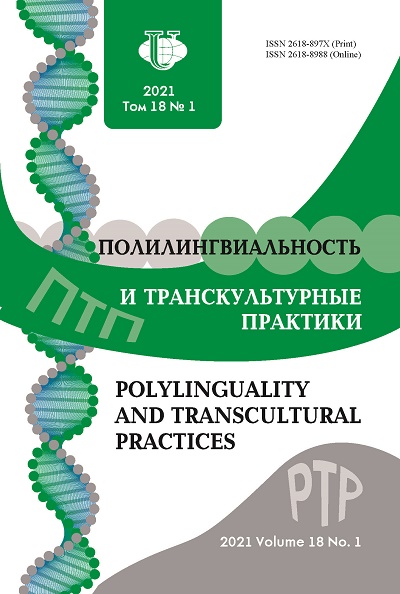Central Asian Social Types as an Orientalism Pattern in Leonid Solovyov’s Prose
- Authors: Shafranskaya E.F.1, Volokhova T.V.1
-
Affiliations:
- Moscow City University
- Issue: Vol 18, No 1 (2021)
- Pages: 44-59
- Section: LITERARY SPACE
- URL: https://journals.rudn.ru/polylinguality/article/view/25934
- DOI: https://doi.org/10.22363/2618-897X-2021-18-1-44-59
Cite item
Full Text
Abstract
The literary work of the Russian writer Leonid Solovyov (1906-1962) was widely known in the Soviet period of the twentieth century - but only by means of the novel dilogy about Khoja Nasreddin. His other stories and essays were not included in the readers’ repertoire or the research focus. One of the reasons for this is that the writer was repressed by Stalinist regime due to his allegedly anti-Soviet activities. In the light of modern post-Orientalist studies, Solovyov’s prose is relevant as a subcomponent of Russian Orientalism both in general sense and as its Soviet version. The “Oriental stories” series, which is the subject of this article, has never been the object of scientific research before. The authors of the article are engaged, in a broad sense, in identifying the features of Solovyov’s Oriental poetics, and, narrowly, in revealing some patterns of the Central Asian picture of the world. In particular, the portraits of social and professional types, met by Solovyov there in 1920-1930, are presented. Some of them have sunk into oblivion, others can be found today, in the XXI century. Comparative, typological and cultural methods are used in the interdisciplinary context of the article.
Keywords
About the authors
Eleonora F. Shafranskaya
Moscow City University
Author for correspondence.
Email: shafranskayaef@mail.ru
Doctor of Philology, Associate Professor, Professor of the Department of Russian Literature, Institute of Humanities
4, building 1, 2nd Agricultural passage, Moscow, 129226, Russian FederationTatyana V. Volokhova
Moscow City University
Email: tvvolokhova@gmail.com
graduate student of department of the Russian literature, Institute of Humanities
4, building 1, 2nd Agricultural passage, Moscow, 129226, Russian FederationReferences
- Solov’ev, L.V. 2010. Collected works: In 5 vol. Vol. 2. Moscow: Knigovek publ. Print. (In Russ.)
- Kantorovich, Vl. 1974. “Ocherk”. In Slovar’ literaturovedcheskih terminov. Eds. L.I. Timofeev, S.V. Turayev. Moscow: Prosveshhenie publ. Print. (In Russ.)
- Pospelov, G.N. 1987. “Ocherk”. In Literaturnyj jenciklopedicheskij slovar’. Eds.V.M. Kozhevnikov and P.A. Nikolaev. Moscow: Sovetskaja jenciklopedija publ. Print. (In Russ.)
- Gordeeva, E.Ju. 2003. “Ocherk”. In Literaturnaja jenciklopedija terminov i ponjatij. Ed.by A.N. Nikolyukin; INION. Moscow: Intelvak publ. Print. (In Russ.)
- Ginzburg, L.Ja. 1977. O psihologicheskoj proze. Leningrad: Hudozhestvennaja literatura publ. Print. (In Russ.)
- Vereshhagin, V.V. 1990. “Iz puteshestvija po Srednej Azii”. In V.V. Vereshhagin. Povesti. Ocherki. Vospominanija. Moscow: Sovetskaja Rossija publ. Print. (In Russ.)
- Lykoshin, N. 1916. Polveka v Turkestane: Ocherki byta tuzemnogo naselenija. Petrograd: V.A. Berezovskij publ. Print. (In Russ.)
- Stratonov, V.V. 2019. Po volnam zhizni: in 2 vol. Moscow: Novoe literaturnoe obozrenie publ. Print. Vol. 1. (In Russ.)
- Shafranskaja, E.F. 2014. A.V. Nikolaev — Usto Mumin: sud’ba v istorii i kul’ture. Rekonstrukcija biografii hudozhnika. Saint-Petersburg: Svoye izdatel’stvo publ. Print. (In Russ.)
- Karazin, N.N. 1905. “T’ma neprogljadnaja”. In N.N. Karazin. Complete works: In 20 vol. Vol. 6. Saint-Petersburg: P.P. Sojkin publ. Print. (In Russ.)
- Shafranskaja, E.F. 2020. Ustnoe narodnoe tvorchestvo: textbook and practical work, the 2nd edition processed and added. Moscow: Jurajt publ. Print. (The higher education). (In Russ.)
- Karazin, N.N. 1905. “Tjurkmen Sjarkej”. In N.N. Karazin. Complete works: In 20 vol. Vol. 16. Saint-Petersburg: P.P. Sojkin publ. Print. (In Russ.)
- Alennik, Je.M. 1985. Napominanie: Povesti. Leningrad: Sovetskij pisatel’ publ. Print. (In Russ.)
- Krestovskij, V.V. 1899—1900. “V dal’nih vodah i stranah”. In V.V. Krestovskij. Collected works: in 8 vol. Ed by Yu.L. Elts. Vol. 6. Saint-Petersburg: Obshhestvennaja pol’za publ. Print. (In Russ.)
- Tageev, B. 1925. Rustam bek. Junuska arbakesh: Povest’ iz zhizni uzbekov s prilozheniem ocherka o Turkestane. Moscow, Leningrad: Gosizdat publ. Print. (In Russ.)
- Belkin, A.A. 1975. Russkie skomorohi. Moscow: Nauka publ. Print. (In Russ.)
- Shafranskaya, E.F. 2018. «Novel “Return to Panjrud” by Andrei Volos as Reconstruction of Daily Life of Maverannahr and Poet’s Rudaki Fate». Polylinguality and Transcultural Practices 15 (4): 618-627. Web. doi: 10.22363/2618-897X-2018-15-4-618-627
- Kol’cova, I.V. 1980. Po sledam Nasreddina: Dilogija L. Solov’eva o Hodzhe Nasreddine. Tashkent:Publishing house of literature and art of Gafur Gulyam publ. Print. (In Russ.)
- Lykoshin, N.S. 1915. Divana-i-Mashrab: zhizneopisanie populjarnejshego predstavitelja misticizma v Turkestanskom krae. Samarkand: Samarkand regional statistical committee publ. Print. (In Russ.)















